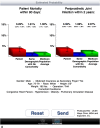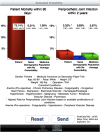Estimating risk in Medicare patients with THA: an electronic risk calculator for periprosthetic joint infection and mortality
- PMID: 23179112
- PMCID: PMC3549162
- DOI: 10.1007/s11999-012-2605-z
Estimating risk in Medicare patients with THA: an electronic risk calculator for periprosthetic joint infection and mortality
Abstract
Background: Although risk factors for periprosthetic joint infection (PJI) and mortality after total hip arthroplasty (THA) have been identified, interactions between specific patient risk factors are poorly understood. Therefore, it is difficult for surgeons to counsel patients on their individual risk of PJI or mortality after THA.
Questions/purposes: We evaluated the interaction between patient clinical and demographic factors on the risk of PJI and mortality after THA and developed an electronic risk calculator for estimating the patient-specific risk of PJI and mortality in Medicare patients with THA.
Methods: We used the Medicare 5% sample claims database to calculate the risk of PJI within 2 years and mortality within 90 days after THA in 53,252 Medicare patients with primary THAs between 1998 and 2009. Logistic regression using 29 comorbid conditions, age, sex, race, and socioeconomic status were used as inputs to develop an electronic risk calculator to estimate patient-specific risk of PJI and mortality after THA.
Results: The overall 2-year risk of PJI and 90-day risk of mortality after primary THA were 2.07% and 1.30%, respectively. White women aged 70 to 74 years with alcohol abuse, depression, electrolyte disorder, peptic ulcer disease, urinary tract infection, rheumatologic disease, preoperative anemia, cardiopulmonary (cardiac arrhythmia, congestive heart failure, ischemic heart disease, chronic pulmonary disease) comorbidities, and peripheral vascular disease were at highest risk for PJI. White women aged 65 to 69 years with electrolyte disorder, hemiplegia/paraplegia, hypertension, hypothyroidism, metastatic tumor, preoperative anemia, coagulopathy, cardiopulmonary (congestive heart failure, chronic pulmonary disease) and psychiatric (psychoses, depression) comorbidities, malignancies, and peripheral vascular disease were at highest risk for mortality. An electronic risk calculator was developed to estimate the risk of PJI and mortality in Medicare patients with THA.
Conclusions: This electronic risk calculator can be used to counsel Medicare patients regarding their patient-specific risks of PJI and mortality after THA.
Level of evidence: Level II, prognostic study. See the Instructions for Authors for a complete description of levels of evidence.
Figures







References
-
- American Academy of Orthopaedic Surgeons. Total hip replacement. Available at: http://orthoinfo.aaos.org/topic.cfm?topic=a00377. Accessed November 22, 2011.
-
- Dearborn JT, Harris WH. Postoperative mortality after total hip arthroplasty: an analysis of deaths after two thousand seven hundred and thirty-six procedures. J Bone Joint Surg Am. 1998;80:1291–1294. - PubMed
MeSH terms
Substances
LinkOut - more resources
Full Text Sources
Other Literature Sources
Medical
Research Materials

